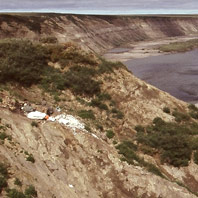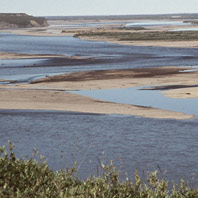The Producer's Story:
Walking a Tightrope in Alaska
by Chris Schmidt
If you watched "Arctic Dinosaurs" in the comfort of your
living room, you probably weren't thinking about what it took
to secure that footage shot on the Colville River in northern
Alaska. It's remote and forbidding terrain, sure, and the
weather could get unpleasant, but for the most part what you
were looking at likely seemed reasonably straightforward,
right? I mean, how hard can it be to shoot a hole in the
ground?
That everything-under-control sense is a bit of an illusion. I
learned that firsthand in August 2006, when I joined
Australian filmmaker Ruth Berry on the first "Arctic
Dinosaurs" filming expedition. With each passing day on that
journey, it came home to me more fully, more chillingly, just
how inhospitable and potentially deadly working in such an
inaccessible locale can be. How completely city-dwellers like
myself relied on the expertise of the pilots, guides, and
seasoned field researchers on the expedition. And how one
wrong step—like the one I made at one point while
inching across the face of a mud-slick cliff 20 stories above
the river—could mean disaster.
That particular moment, which was emblematic of the potential
perils we faced, and anyone faces, working in a place like
Alaska's North Slope, reminds me a little too literally of a
tightrope walker high above, say, Niagara Falls: Everything is
fine until it isn't, and then you're in trouble.
The flight
That feeling of hanging on the coattails of people who
actually knew what they were doing in such an environment
began right at the beginning of the expedition. Our goal was
to join paleontologist Tony Fiorillo and his team at their
fossil dig site on the Colville, but there's not so much as a
dogsled trail across the tundra up there, much less a highway.
Our route would be by air and river.
In Fairbanks, as Ruth and I, along with a film crew and a
wilderness guide, loaded the 12-person, single-engine plane
with our tents and supplies, the pilot told us what lay ahead.
We would fly north for several hours, then pass through a
notch in the Brooks Range and land in Inupiat Eskimo territory
on the North Slope. We were told at takeoff that if the
weather was overcast at either the notch or the landing site,
the pilot would have to turn back. Flying with low visibility
through these 9,000-foot crags would be, well, ill-advised.
Later, as our little plane neared the Brooks Range, my heart
sank—it was totally socked in. But our pilot simply
said, "Oh, hell, I've done this before," and flew right into
the cloudbank. Soon enough we landed at the
settlement—which was also socked in.
So why the pilot's preamble? I wondered. His slightly
bemused expression offered a clue—I'd just gotten the
classic greenhorn treatment. Still, it was the first of many
instances of feeling a bit like I was walking a tightrope.
The boat trip
The settlement, perched on the edge of the Colville River, is
called Umiat. Little more than an airstrip, a fuel dump, and
some World War II-era Quonset huts, Umiat serves as a kind of
base camp for oil prospectors, geologists, and Bureau of Land
Management (BLM) operatives. For us it was the launching point
for our transport to the fossil dig site—an 18-foot,
flat-bottomed boat powered by a small outboard and loaded with
several 5- or 10-gallon gas canisters.
The day would have passed in relative comfort if the boat had
had a roof. But it was open to the four winds, and as we began
to head downriver—which meant, counterintuitively,
traveling due north towards the Arctic Ocean—we quickly
began to bemoan the lack of a proper enclosure. For four long
hours, as we motored the 50 miles or so to Tony's camp, we
huddled under tarps against a maddeningly steady, freezing
rain that buffeted us the entire trip. Wasn't August in Alaska
supposed to be warm?
I suddenly felt the thin support under my feet give way, and I
started to fall.
Despite the discomfort, it was impossible not to be astonished
by the tall cliffs and arrestingly barren landscape that
surrounded us. And by the knowledge that in that vast,
unbroken, arctic wilderness, someone had actually come
upon dinosaur fossils. Aside from thinking of dinosaurs as
warm-weather creatures, I thought that either Tony Fiorillo
had been incredibly lucky—like winning-the-lottery
lucky—or dinosaur bones must lie everywhere on
the North Slope, in such profusion that he had only to decide
to look for them in order to find them.
In fact, Tony told me later that he located his dig site
simply by riding downriver, as we were doing, and looking for
rocks in the cliff faces that matched the kind of rocks at the
Liscomb bone bed, a site along the Colville that was the first
dinosaur fossil bed discovered in the Alaskan Arctic. When
Tony finally did spot some of that rock, crumbled in a pile at
the bottom of a cliff, he found dinosaur remains nearby. It
was that easy.
The site
"Easy" was not the first word to come to mind when we finally
arrived at Tony's site and looked up toward the dig. (The site
is called Kikak-Tegoseak, in honor of two local Inupiat
families.) It turns out that Tony's rocks had eroded out of
the very top of one of those cliffs. His quarry was 300 feet
above the river—a football field in length, more or less
straight up. The only way you could get there was by climbing
200 feet up a steep, muddy ridgelet and then inching across
the cliff face on a ledge just a few inches wide, your face
occasionally pressed up against the dirt. I have a mild fear
of heights, which didn't help.
Remember that "one wrong step" I mentioned? Well, this is
where I took it. Maybe I was thinking about our cameraman,
Paul Warren, who, with our bulky film camera in his backpack,
was alarmingly top-heavy. Or maybe I was wishing I'd brought
rubber muck boots like Tony had rather than my hiking boots,
each of which was by then encased in about two or three pounds
of mud and had zero purchase. Or maybe I was wondering how I'd
stop my body, if I slipped, from tumbling and sliding all the
way down that 200-foot slab of melting ice-cream cake and into
the icy water.
Whatever, I suddenly felt the thin support under my feet give
way, and I started to fall. My right hand shot out, grabbing
frantically at the wall. Somehow it latched onto a thin branch
or root, which was busy fighting its own battle with erosion
and gravity. Miraculously, this humble twig held long enough
that I was able to find firmer footing. Staring then with a
kind of sick fascination at the hypothermic water below, the
adrenaline pumping through my veins, I couldn't help saying to
myself, "All this just for some old bones?"
The finds
Yes. That's the answer that came readily to mind when I
safely reached the site and saw what was being unearthed
there. For in the rain-loosened permafrost at my feet, Tony
and his fellow paleontologists were finding the fossil bones
of 70 million-year-old dinosaurs. Big ones. Altogether, they
uncovered eight genera among the hundreds of fossil bones,
including the Triceratops-like
Pachyrhinosaurus and the 30-foot-long, 40-ton
Edmontosaurus. There were also meat-eaters, small ones
like the 150-pound Troodon and big,
top-of-the-food-chain ones like Gorgosaurus, a
T. rex lookalike.
It was truly one of the saddest moments in my life when I saw
that helicopter take off without us.
I realized that only time separated us on that windswept bluff
from the living dinosaurs, which now remained only as rocks.
They were here. Gazing around at the harsh, impersonal
tundra and the braided river far below, I felt that the
fascinating but intellectually remote story of life on Earth
had suddenly become real, palpable. I felt overwhelmed, truth
be told, even a little frightened. There was so much at hand
that was simply vast, unknowable, almost alien. It was as if
we were excavating among the planets....
The return
Such wistful musing didn't last long. We still had to get down
that cliff at the end of the day. We still had to camp that
night on a frigid gravel bar jutting into the river. (The BLM
wouldn't allow us to camp on the vulnerable tundra atop the
cliff.) And we still had to be on our guard for grizzlies. "If
you have to get up in the middle of the night, whistle so you
don't startle Mr. Bear," our ex-Special Forces guide had
warned us with a wink.
What about in my tent, the one with the flimsy walls and
roof?
I wondered to myself. Should I whistle all night?
Finally, we still had to get back to civilization. It was bad
enough that the weather turned nasty again just as we were
setting out in that same accursed open boat. But I for one
hadn't foreseen the radical difference between heading
upstream rather than down. As luck would have it, a
recent rainstorm up in the mountains had caused a torrent of
water draining out of the Brooks Range to raise the Colville's
level, which ratcheted up the speed of the current. It soon
grew so strong that, as a glance at the riverbank revealed,
our boat, even on full throttle, barely moved forward. Plus,
every five minutes or so, we had to pull up to a gravel bank
and shut down the motor so our guide could hop out in his
waders and clear the impellers of the floral debris that kept
clogging them. The wilderness, by that point, had become more
foe than source of inspiration.
And then we ran out of gas. That one wrong step at last?
Fortunately not. Our balky satellite phone behaved, and before
long a helicopter arrived with a 20-gallon drum of fuel. It
was truly one of the saddest moments in my life when I saw
that helicopter take off without us.
Can't you take me? I thought in unabashed
self-interest.
The upshot
The trip downriver had been four hours; the trip back up was
16. We didn't arrive at Umiat until midnight. After a few
drinks to warm our deeply chilled selves, we collapsed into
well-deserved sleep. When we finally flew back to Fairbanks, I
thought to myself that, by and large, that had been one of the
most uncomfortable and hair-raising experiences of my life.
Didn't look like it on screen, did it?






